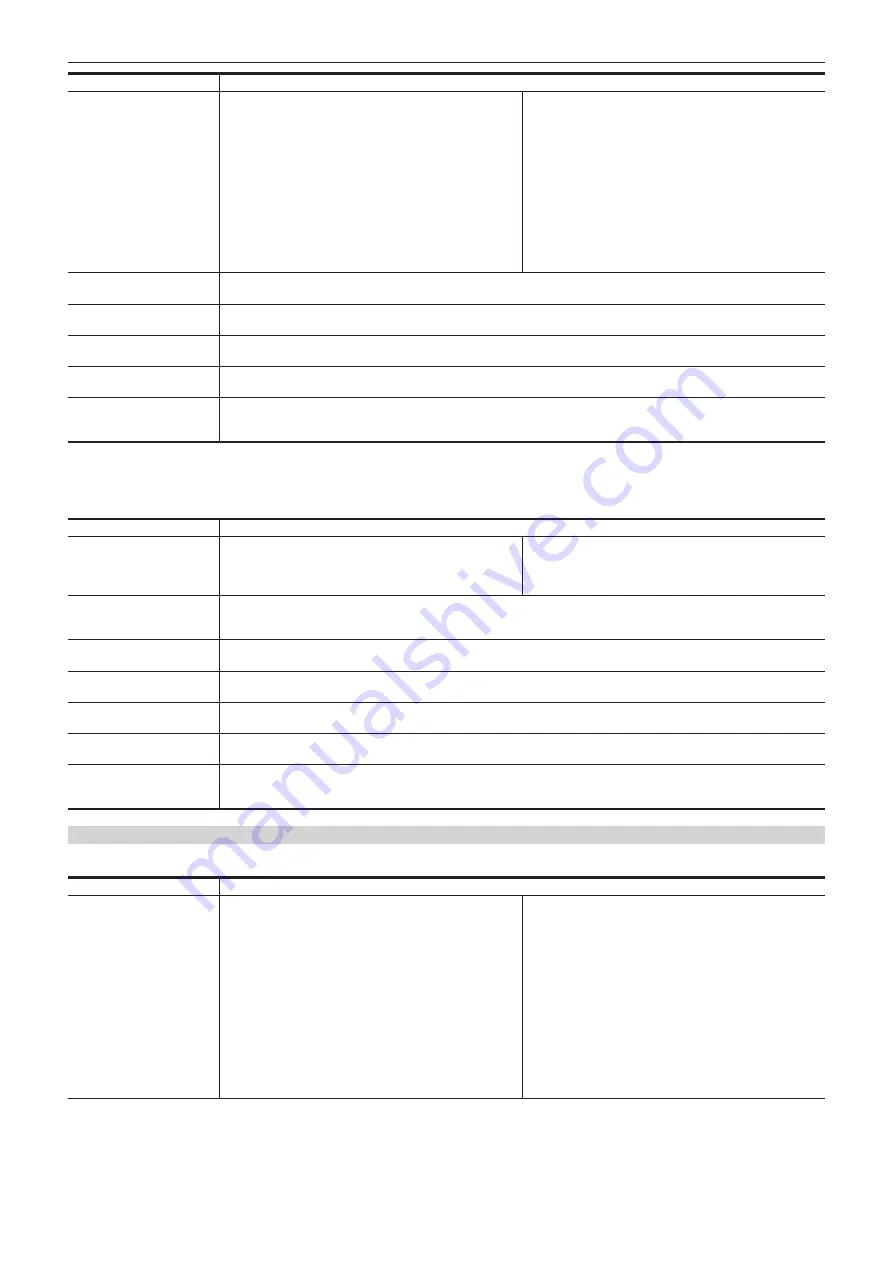
– 163 –
Chapter 7 SmartUI operation — SmartUI menu list
Corresponding button
Setting details and setting value
<STOP> button
[TC_MD]
Selects the advance setting mode for the built-in time code
generator.
[F-RUN]
Use this function to advance the time code continuously,
regardless of the P2 card recording operation. Set to this
position to, for example, set the time code to the current time or
externally lock the time code.
[R-RUN]
Use this function to advance the time code only during
recording. A time code recorded normally will be continuously
recorded.
f
If a clip is deleted, or if the frame rate is set to [24PN] and the
recording continues to a clip other than [24PN], continuous
recording may fail.
f
Factory setting: [F-RUN]
<FF/
)
> button
[
−
]
Decreases the setting value of the selected digit in the time code.
<PLAY/PAUSE> button
[
+
]
Increases the setting value of the selected digit in the time code.
<COUNTER> button
[TC/UB]
Switches to the user bits setting screen.
<RESET> button
[RST]
Resets all time code setting values to 0.
<MONITOR SEL> button
[
→
]
Moves the selected digit in the time code to the right. When the selected digit moves to the right edge, it moves back to the left
edge.
r
User bits settings screen:
f
To set the user bits, press the <
%
/REW> button to change to the user bits setting mode.
f
The setting values of each digit of the user bits are from
[0] to [F]
(hexadecimal).
Corresponding button
Setting details and setting value
<
%
/REW> button
[UBG]
Starts and exists the user bits setting mode.
f
The user bits setting is applied when the setting mode exits.
When the <
%
/REW> button is pressed, [SET] is displayed in
black and white inversion, and the user bits setting mode is set.
When the <
%
/REW> button is pressed again, [SET] returns
to the normal display, and the user bits setting mode exits.
<STOP> button
[TC_MD]
Switches to the advance setting mode for the built-in time code generator. The setting contents are the same as when [TCG] is
selected.
<FF/
)
> button
[
−
]
Decreases the setting value of the selected digit in the user bits.
<PLAY/PAUSE> button
[
+
]
Increases the setting value of the selected digit in the user bits.
<COUNTER>
[TC/UB]
Switches to the time code setting screen.
<RESET> button
[RST]
Resets all user bits setting values to 0.
<MONITOR SEL> button
[
→
]
Moves to the right of the selected digit in the user bits. When the selected digit moves to the right edge, it moves back to the left
edge.
[SET02:MON OUT SELECT]
Sets the formats and aspects of video output from the <SDI OUT2/IN> terminal, the <HDMI> terminal, and the <GL IN/VIDEO OUT> terminal.
Corresponding button
Setting details and setting value
<
%
/REW> button
[SDI2]
Sets the signal format type output from the <SDI OUT2/IN>
terminal.
With this setting, the signal format to be output from the
<HDMI> terminal is also switched.
f
When the main menu
→
[IN/OUT SEL]
→
[HDMI OUT
SIGNAL] is set to [VF], the 1080i signal is output from the
<HDMI> terminal, regardless of this setting.
When [SDI IN] is selected, the signals 1080i, 720P, 480P, or
576P are output in accordance with the setting in the main
menu
→
[SYSTEM MODE]
→
[LINE&FREQ].
[1080i] or [720P] (HDMI: [1080i] or [720P])
Displayed only in the HD mode.
f
Outputs the SDI signal in accordance with the setting in the
main menu
→
[SYSTEM MODE]
→
[LINE&FREQ].
f
The 1080i or 720P signal is also output from the <HDMI>
terminal according to the [LINE&FREQ] setting.
f
For [1080-59.94P] or [1080-50P], 1080/59.94i and 1080/50i
is output from both the <SDI OUT2/IN> terminal and the
<HDMI> terminal.
f
For [1080-23.98PsF], the signal pulled down to 1080/59.94i
is output from both <SDI OUT2/IN> and <HDMI> terminals.
[480i] or [576i] (HDMI: [480P] or [576P])
f
The SDI signal of 480i or 576i is output.
f
The 480P or 576P signal is output from the <HDMI> terminal.
Summary of Contents for PX380G-BS300
Page 9: ...Before using the camera read this chapter Chapter 1 Overview ...
Page 165: ...Details displayed on the viewfinder are described Chapter 8 Display ...
Page 213: ...Maintenance and error messages of the camera are described Chapter 11 Maintenance ...
Page 219: ...This chapter describes the specifications of this product Chapter 12 Specification ...






























